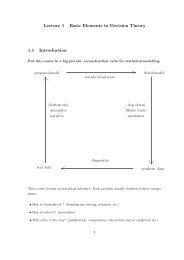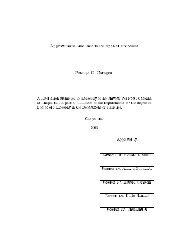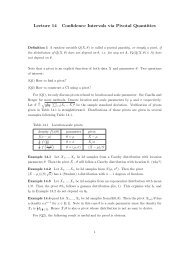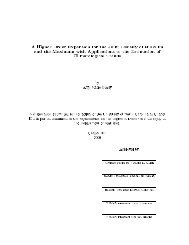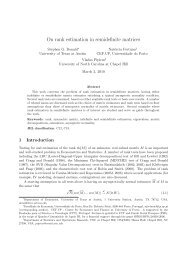Monte Carlo Methods in Statistical Mechanics: Foundations and ...
Monte Carlo Methods in Statistical Mechanics: Foundations and ...
Monte Carlo Methods in Statistical Mechanics: Foundations and ...
You also want an ePaper? Increase the reach of your titles
YUMPU automatically turns print PDFs into web optimized ePapers that Google loves.
unfeasible, but we are free to useany updat<strong>in</strong>g that leaves <strong>in</strong>variant the appropriate<br />
conditional distributions. Of course, <strong>in</strong> this generality \partial resampl<strong>in</strong>g" <strong>in</strong>cludes all<br />
dynamic <strong>Monte</strong> <strong>Carlo</strong> algorithms | we could just take f g to bethe entire system<br />
|butitis<strong>in</strong>many cases conceptually useful to focus on some subset of variables.<br />
The partial-resampl<strong>in</strong>g idea will be at the heart of the multi-grid <strong>Monte</strong> <strong>Carlo</strong> method<br />
(Section 5) <strong>and</strong> the embedd<strong>in</strong>g algorithms (Section 6).<br />
We have nowde nedarather large class of dynamic <strong>Monte</strong> <strong>Carlo</strong> algorithms: the<br />
s<strong>in</strong>gle-sp<strong>in</strong>- ip Metropolis algorithm, the s<strong>in</strong>gle-site heat-bath algorithm, <strong>and</strong> so on.<br />
How well do these algorithms perform? Away from phase transitions, they perform<br />
rather well. However, nearaphase transition, the autocorrelation time grows rapidly.<br />
In particular, near a critical po<strong>in</strong>t (second-order phase transition), the autocorrelation<br />
time typically diverges as<br />
m<strong>in</strong>(L ) z (4.20)<br />
where L is the l<strong>in</strong>ear size of the system, is the correlation length ofan<strong>in</strong> nite-volume<br />
system atthe sametemperature, <strong>and</strong> z is a dynamic critical exponent. This phenomenon<br />
is called critical slow<strong>in</strong>g-down itseverely hampers the study of critical phenomena by<br />
<strong>Monte</strong> <strong>Carlo</strong> methods. Most of therema<strong>in</strong>der of these lectures will be devoted, therefore,<br />
to describ<strong>in</strong>g recent progress <strong>in</strong> <strong>in</strong>vent<strong>in</strong>g new <strong>Monte</strong> <strong>Carlo</strong> algorithms with radically<br />
reduced critical slow<strong>in</strong>g-down.<br />
The critical slow<strong>in</strong>g-down of the conventional algorithms arises fundamentally from<br />
the factthat their updates are local: <strong>in</strong>as<strong>in</strong>gle step of the algorithm, \<strong>in</strong>formation" is<br />
transmitted from a given siteonlytoitsnearest neighbors. Crudely onemightguessthat<br />
this \<strong>in</strong>formation" executes a r<strong>and</strong>om walk around thelattice. In order for the system to<br />
evolve to an \essentially new" con guration, the \<strong>in</strong>formation" has to travel a distance<br />
of order ,the (static) correlation length. One would guess, therefore, that 2 near<br />
criticality, i.e. that the dynamic critical exponent z equals 2. This guess is correct for<br />
the Gaussian model (free eld). 12 For other models, we have asituation analogous to<br />
theory of static critical phenomena: thedynamic critical exponentisanontrivial number<br />
that characterizes a rather large class of algorithms (a so-called \dynamic universality<br />
class"). In any case, for most models of <strong>in</strong>terest, the dynamic critical exponent for<br />
local algorithms is close to 2(usuallysomewhat higher) [21]. Accurate measurements<br />
of dynamic critical exponents are,however, very di cult |even more di cult than<br />
measurements ofstatic critical exponents |<strong>and</strong> require enormous quantities of <strong>Monte</strong><br />
<strong>Carlo</strong> data: run lengths of 10000 ,when is itself gett<strong>in</strong>g large!<br />
We can now make a rough estimate ofthe computer time needed to study the Is<strong>in</strong>g<br />
model near its critical po<strong>in</strong>t, or quantum chromodynamics near the cont<strong>in</strong>uum limit.<br />
Eachsweepofthelattice takes a timeoforder L d ,where d is thespatial (or space-\time")<br />
dimensionality ofthe model. And weneed 2 sweeps <strong>in</strong> order to get one \e ectively<br />
12 Indeed, for the Gaussian model this r<strong>and</strong>om-walk picture can be made rigorous: see [19] comb<strong>in</strong>ed<br />
with [20, Section 8].<br />
21



